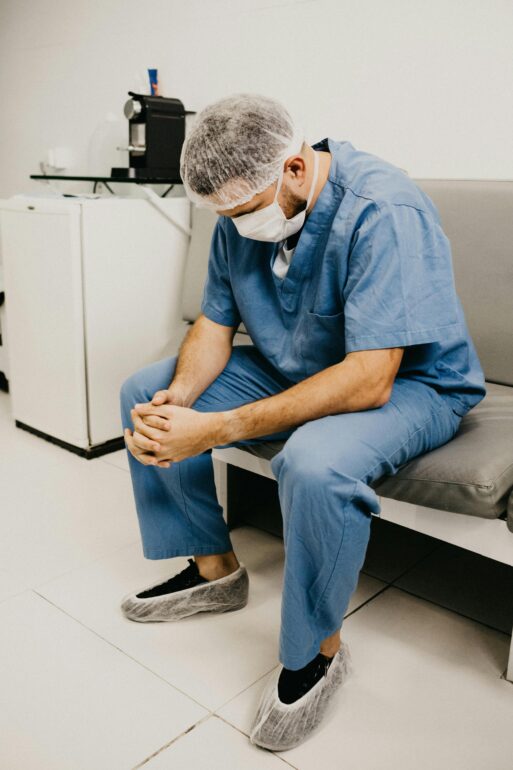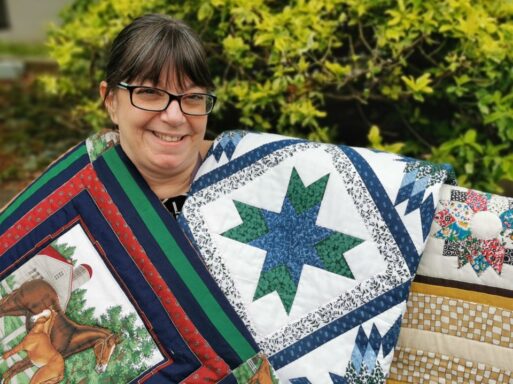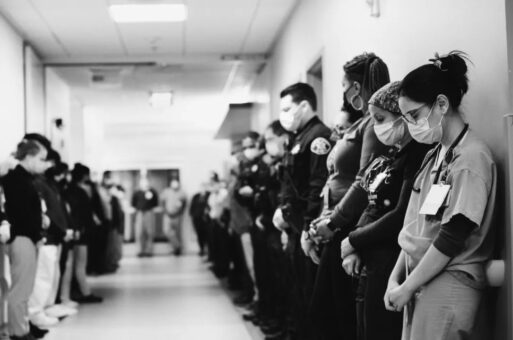
An exhausted doctor takes a brief moment to process the death of a patient before moving on to other responsibilities
While the average person might bear witness to death once or twice in their lifetimes, medical providers working in nursing homes, hospice and emergency medicine can witness death daily.
Often the demands of the job require providers to swiftly continue aiding others in need of medical care after a loss. Because they are on the clock, medical providers don’t get space to process that they have just witnessed the final moments of an individual — someone who was once a young, curious child, someone who had been loved deeply, someone who will be missed dearly.
But just because death is a part of one’s job doesn’t take away the impact it has on providers as human beings. Finding ways to honor the patient and honor one’s role as a witness to their death can be beneficial not just for medical providers but also the patient’s family.
The Pause

After the death of a patient, some practitioners conduct a “Pause,” a moment of silence that typically lasts 45 seconds to 1 minute to honor the patient. The idea of The Pause is to allow medical providers in the room to process the moment and acknowledge the individual they all witnessed transition from life to death before moving forward with further procedures. In this moment of silence, care providers with various beliefs and backgrounds are invited to engage in a spiritual practice that respects everyone in the room. Family members who are present can share the experience and engage in the Pause with the care providers. This moment helps give a sense of community in a moment of great shock for families.
Code Dove

Peggy Sauve, assistant director of resident care at the IOOF Home in Barrie, displays the dignity quilts that were donated by the Elmvale Presbyterian Church craft group.
Credit: Wayne Doyle/BarrieToday
IOOF Senior Homes’ palliative care program located in Ontario, Canada, started their own unique practice to honor patients who have made their final rite of passage. As a senior living facility, many care providers are with their patients at the final stages of life. These providers have built a special, yet brief, relationship with their patients, which often makes losing a patient especially difficult. To honor the life of a resident who has just died, staff members call a “Code Dove” over the intercom. Following the announcement, staff and residents join the family and gather at the front entrance to bid them farewell as they exit the facility for the last time. The resident’s favorite music is played over speakers and residents and staff hold flameless candles in honor of them.
To make it even more personal, the body is shrouded in a dignity quilt, a quilt made specifically for covering the body, thoughtfully handmade by members of the Elmvale Presbyterian Church craft group. Each quilt contains different themes that can relate to resident’s interests or hobbies to further personalize the experience.
The effect of “Code Doves” on the families, residents and caregivers have been deeply moving. Families feel like their loved one was known and loved in their community, residents get a way to honor and celebrate their friend, and caregivers get a chance to say goodbye to a resident they have spent many months or years caring for.
Honor Walks

Courtesy of Ryan Sin / Loved Ones of Jen Angel
When a person dies in a hospital and has elected to donate their organs, the body is often quickly moved into an operating room. When the family requests an honor walk, the staff caring for the patient send a notification to other staff in the hospital that the transport is taking place. Those who are available and wish to participate line the hallways to show their respect for the individual who has chosen to give up parts of their body to others in need. Moving at a slow and dignified pace, a speed unfamiliar to many in the hospital setting, staff members have a chance to acknowledge the sanctity of human life and express gratitude for the individual’s gifts, which may one day save the life of another. This tribute offers a moment for family members to be with their loved one’s body and absorb the medical community’s appreciation for their loved one’s decision to donate.
Amidst the diagnostics, protocols and procedures, Honor Walks, Code Doves and Pauses give medical providers an opportunity to slow down and embrace the preciousness of life. These practices also show family members that their loved one’s life has been honored by those who have provided care for them in their final moments. Seeing this expression of respect can offer a feeling of comfort and community to those enduring one of life’s most difficult moments.

 Three Ways Medical Providers Honor Patients After a Death
Three Ways Medical Providers Honor Patients After a Death



 How to Comfort A Dying Loved One
How to Comfort A Dying Loved One
 Our Annual Seven Holiday Gifts for Someone Who Is Grieving, 2024 Edition
Our Annual Seven Holiday Gifts for Someone Who Is Grieving, 2024 Edition














